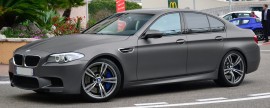 The BMW 7-Series makes a tremendous technological leap with every generation. And rather than keeping its transcendence to what’s under the hood or to technology on the dash, the sixth-generation 2016 BMW 7-Series learns a bit from BMW’s carbon-fiber ‘i’ cars inside and underneath.
The BMW 7-Series makes a tremendous technological leap with every generation. And rather than keeping its transcendence to what’s under the hood or to technology on the dash, the sixth-generation 2016 BMW 7-Series learns a bit from BMW’s carbon-fiber ‘i’ cars inside and underneath.
The 2016 7-Series is about the same size as the outgoing car, yet it’s built on a new Carbon Core platform that uses a combination of carbon fiber-reinforced plastic (CFRP), ultra-tensile steels, and aluminum to cut up to 90 pounds there alone. The 7-Series’ doors and hood are made of aluminum, lighter weight suspension components cut 15 percent of the unsprung mass, and BMW notes that the 7-Series keeps a perfect 50/50 weight distribution.
BMW keeps the exterior design of the 7-Series remarkably clean, and it builds on the classic sport-sedan proportions that the brand has reestablished with the current 3-Series and 5-Series models. Just as we’ve seen in BMW’s recently renewed utility vehicles, there’s a larger, taller version of the brand’s twin-kidney grille—a so-called Active Kidney Grille that manages airflow for efficiency—while a beautifully sculpted beltline crease rises from the hood and continues, in subtle fashion, all the way to the rear lamps and a chrome accent bar across the rear. A chiseled piece of brightwork starts behind the front wheelwells, where it incorporates an air breather, and continues along the lower side of the vehicle, taking visual weight out of the car’s profile.
Inside, BMW continues some of the design themes it’s already embarked upon with other recent vehicles. The instrument panel gets more shelf-like and horizontal than ever. There’s more brightwork here than in the outgoing 7-Series, with a satin-metallic look that also involves the facing for climate and audio controls. Yet the look remains relatively formal.
The 2016 BMW 7-Series arrives in the U.S. market in 740i, 750i (both with rear-wheel-drive), and 750i xDrive (all-wheel-drive) forms. The 740i is is motivated by a TwinPower turbocharged 3.0-liter in-line six-cylinder engine making 320 horsepower, with the 750i packing a 4.4-liter TwinPower turbocharged V-8 that produces 445 hp. BMW says that the efficiency of both engines has been increased.
Sometime next year a new 740e xDrive plug-in hybrid model will join the lineup. With a 2.0-liter turbocharged gasoline four-cylinder engine, an electric-drive unit that’s integrated within an eight-speed automatic transmission, and a lithium-ion battery pack mounted under the rear seat, the 740e xDrive will be able to go an estimated 23 miles in eDrive mode, without the gasol
engine starting. However, this mode is limited to 75 mph. There’s also a Battery Control mode that allows drivers to maintain or gain battery charge while driving in combined hybrid mode, therefore saving the electric driving for dense urban areas.
The chassis controls that underpin the 7-Series become far more complex this year. A new feature called Active Comfort Drive with Road Preview adds anticipatory functions to the active-chassis system and air suspension (which has now been extended even to the base 740i), while the Integral Active Steering (rear-wheel steering) has been reengineered so it can now be offered in combination with all-wheel drive.
BMW notes that its eight-speed automatic transmission is now linked to navigation-system data, allowing the shift characteristics to change with curves and terrain. Auto Start Stop turns off the engine temporarily at stoplights, while the powertrain allows decoupled coasting at speeds up to 100 mph.
As part of the revamped instrument-panel design, the corners have been pushed farther outward, at least visually, creating a little more perceived cabin space for those in the front seats. U.S. models only get long-wheelbase versions with an additional inch of rear legroom. The back seat area, as it always has for the 7-Series, can be equipped for typical luxury-sedan accommodations or something far greater and chauffeur-worthy. New ambient lighting and a fragrance option help personalize the interior, while there’s a panoramic LED roof available. All doors now have a soft-close feature.
Now that heated rear seats are more common, the 7-Series takes it a step farther, with heated armrests, front and rear. A Luxury Rear Seating Package adds those plus rear ventilated and comfort seats, and a removable Touch Command Tablet, with wireless hotspot, for those in back. There’s also a massage function, and rear-seat passengers get a ‘Vitality Program’ so that “passengers can engage in active training to revitalize the body on longer journeys.” Separately, there’s a Rear Executive Lounge Seating Package that gives the right rear passenger an extra 3.5 inches of legroom and a footrest. That package also includes a fold-out table, two cupholders, and a separate storage compartment.
The 7-Series isn’t just the flagship of the BMW line but also the debut stage for leading-edge technology features that eventually trickle down to the brand’s other models. This model is no exception. There’s a new Gesture Control feature for the iDrive interface, as well as a newly available wireless charging system. The head-up display covers a larger area, and a second-generation Night Vision 2 system adds Pedestrian Detection, while new Adaptive Headlamps now take into account speed, steering angle and yaw.
BMW is finally caving to touch-screen technology in its cars as well. The 2016 7-Series, with iDrive 5.0, includes a big 12.3-inch landscape-oriented touchscreen display. Bowers & Wilkins surround sound, with 1,400 watts and 16 speakers, should help take care of your entertainment needs, too.
